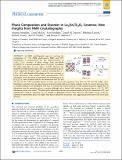Files in this item
Phase composition and disorder in La2(Sn,Ti)2O7 ceramics : new insights from NMR crystallography
Item metadata
| dc.contributor.author | Fernandes, Arantxa | |
| dc.contributor.author | McKay, David | |
| dc.contributor.author | Sneddon, Scott | |
| dc.contributor.author | Dawson, Daniel McLean | |
| dc.contributor.author | Lawson, Sebastian | |
| dc.contributor.author | Veazey, Richard | |
| dc.contributor.author | Whittle, Karl | |
| dc.contributor.author | Ashbrook, Sharon Elizabeth | |
| dc.date.accessioned | 2016-10-13T09:30:13Z | |
| dc.date.available | 2016-10-13T09:30:13Z | |
| dc.date.issued | 2016-09-15 | |
| dc.identifier | 245162572 | |
| dc.identifier | 94824bc9-316a-4586-bdda-fd002ef0322b | |
| dc.identifier | 84987943307 | |
| dc.identifier | 000383641700043 | |
| dc.identifier.citation | Fernandes , A , McKay , D , Sneddon , S , Dawson , D M , Lawson , S , Veazey , R , Whittle , K & Ashbrook , S E 2016 , ' Phase composition and disorder in La 2 (Sn,Ti) 2 O 7 ceramics : new insights from NMR crystallography ' , Journal of Physical Chemistry C , vol. 120 , no. 36 , pp. 20288-20296 . https://doi.org/10.1021/acs.jpcc.6b06962 | en |
| dc.identifier.issn | 1932-7447 | |
| dc.identifier.other | ORCID: /0000-0003-0362-7848/work/29608109 | |
| dc.identifier.other | ORCID: /0000-0002-4538-6782/work/56638964 | |
| dc.identifier.other | ORCID: /0000-0002-8110-4535/work/34029113 | |
| dc.identifier.uri | https://hdl.handle.net/10023/9655 | |
| dc.description | SEA would like to thank the ERC (EU FP7 Consolidator Grant 614290 “EXONMR”) and EPSRC for computational support through the Collaborative Computational Project on NMR Crystallography (CCP-NC), via EP/M022501/1, and for other support EP/M506631/1 (SS). SEA would also like to thank the Royal Society and Wolfson Foundation for a merit award. Some of the calculations were performed on the ARCHER UK National Supercomputing Service, and were supported by CCP-NC. KRW acknowledges funding by the EPSRC, (EP/L005581/1), and NGN CDT (EP/L015390/1) and Nuclear First DTC (EP/G037140/1) for PhD funding (RV and SML). The research data (and/or materials) supporting this publication can be accessed at http://dx.doi.org/10.17630/e30fff33-ddb4-4b87-8d86-245bd3529ad8. | en |
| dc.description.abstract | An NMR crystallographic approach, involving the combination of 119Sn NMR spectroscopy, XRD and DFT calculations, is demonstrated for the characterisation of La2Sn2–xTixO7 ceramics. A phase change from pyrochlore (La2Sn2O7) to a layered perovskite phase (La2Ti2O7) is predicted (by radius ratio rules) to occur when x ≈ 0.95. However, the sensitivity of NMR spectroscopy to the local environment is able to reveal a significant two-phase region is present, extending from x = 1.8 to ~0.2, with limited solid solution at the two extremes, in broad agreement with powder XRD measurements. DFT calculations reveal that there is preferential site substitution of Sn in La2Ti2O7, with calculated shifts for Sn substitution onto Ti1 and Ti2 sites (in the “bulk” perovskite layers) in better agreement with experiment than those for Ti3 and Ti4 (“edge” sites). Substitution onto these two sites also produces structural models with lower relative enthalpy. As the Sn content decreases, there is a further preference for substitution onto Sn2. In contrast, the relative intensities of the spectral resonances suggest that Ti substitution into the pyrochlore phase is random, although only a limited solid solution is observed (up to ~7% Ti). DFT calculations predict very similar 119Sn shifts for Sn substitution into the two proposed models of La2Ti2O7 (monoclinic (P21) and orthorhombic (Pna21)), indicating it is not possible to distinguish between them. However, the relative energy of the Sn-substituted orthorhombic phase was higher than that of substituted monoclinic cells, suggesting that the latter is the more likely structure. | |
| dc.format.extent | 2297440 | |
| dc.language.iso | eng | |
| dc.relation.ispartof | Journal of Physical Chemistry C | en |
| dc.subject | QD Chemistry | en |
| dc.subject | DAS | en |
| dc.subject.lcc | QD | en |
| dc.title | Phase composition and disorder in La2(Sn,Ti)2O7 ceramics : new insights from NMR crystallography | en |
| dc.type | Journal article | en |
| dc.contributor.sponsor | EPSRC | en |
| dc.contributor.sponsor | European Research Council | en |
| dc.contributor.sponsor | The Royal Society | en |
| dc.contributor.institution | University of St Andrews. School of Chemistry | en |
| dc.contributor.institution | University of St Andrews. EaSTCHEM | en |
| dc.identifier.doi | 10.1021/acs.jpcc.6b06962 | |
| dc.description.status | Peer reviewed | en |
| dc.identifier.grantnumber | EP/M022501/1 | en |
| dc.identifier.grantnumber | 614290 - EXONMR | en |
| dc.identifier.grantnumber | WM150021 | en |
This item appears in the following Collection(s)
Items in the St Andrews Research Repository are protected by copyright, with all rights reserved, unless otherwise indicated.

